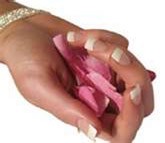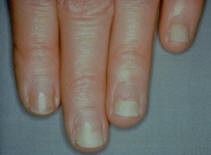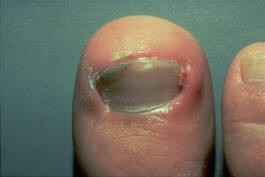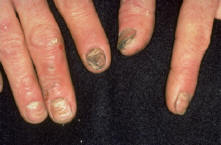Conveniently located to serve Newnan, Peachtree City and LaGrange
Click here to jump to:
Newnan Nail Disorder Review

Nails are an important part of our anatomy. They can be windows to our internal health as their appearance can be altered by medical conditions such as anemia, kidney disease and psoriasis. Nails are subject to the environment, e.g. such as cold, humidity and trauma. The following will review nail anatomy, discuss how nails can be influenced by systemic disease, and outline some good nail hygiene tips.
WHAT, ACTUALLY, DOES THE NAIL ITSELF CONSIST OF?

The nail consists of the nail plate and surrounding structures. The latter include the cuticle, the hyponychium, the lunula, and nail bed.
CUTICLE – The cuticle refers to the rim of the nail where the nail plate meets the finger. The material is made up of a protein, sugar substance referred to a keratin. Keratin is a transparent material which protects the nail from moisture and unwanted bacteria.
HYPONYCHIUM – refers to the space between the nail plate and the nail bed. The hyponychium is thick and protects the under surface of the nail edge It does this by preventing moisture and unwanted bacteria from entering the nail bed.
LUNULA – refers to the visible portion of the nail matrix underneath the nail plate. It resembles a half or crescent moon.
NAIL BED – The nail bed is the area of the nail that is directly under the nail plate and has a robust blood supply. For this treason, it is also referred to as the pulp of the nail. Various medical conditions can alter the normal appearance of the nail bed.
NAIL PLATE – This is the final product of the nail unit. It is comprised of a hard translucent material called keratin and covers from one-seventh to one-half of every finger or toe.
HOW ARE NAILS INFLUENCED BY SYSTEMIC DISEASES?
Nail abnormalities are important to dermatologists, especially because they can give us clues as to what other medical problems a patient may have. It is important to look at all twenty nails when assessing nail health. Nails can change in color, size, texture and thickness. One of the more common nail changes, that a dermatologist observes is a condition called “pitting” of the nails. This observation can be seen in conditions such as psoriasis, hair loss and lichen planus. Nails can also be noted on occasion to separate from the nail plate, a condition referred to as “onycholysis”. Psoriasis, fungal disease, thyroid disease, trauma, drug reactions, local allergies can cause nail separation to occur. Color changes can also occur in the nail. For example, blue nails can be a sign of copper poisoning whereas red nails can be associated with such things as carbon monoxide poisoning, rheumatoid arthritis and liver disease. Nails can also alter their shape. Clubbing of the nails is an example of this. In this condition, the nail actually becomes thickened and over grown while the cuticle becomes spongy in its texture. Clubbing can be a sign of respiratory disease. Conversely, spoon nails, where the nail tends to curve inward like a spoon, may be a sign of iron deficiency anemia.
Patient
Review
“Very warm and friendly environment, I did not feel rushed.”
by Anonymous
WHAT ARE SOME OF THE MEDICATIONS THAT CAN AFFECT NAILS?

Tetracycline induced nail disease.
Antibiotics, such as tetracycline or sulfa, can cause nail changes. Tetracycline can cause pigment of the nails and nail bed separation, especially with sun exposure. Sulfa drugs can cause a white discoloration of the nail. Chemotherapy can also cause nail color change and sensitivity.
WHAT ABOUT THE COSMETIC APPEARANCE OF NAILS?
Patients sometimes complain that they find that their nails are growing slowly or are thin and fragile. It is frustrating to experience a split, chipped or broken nail. To combat some of these issues, studies have shown that Biotin can strengthen nails at a dose of 2.5 grams a day. Cuticle creams and nail enamels, can also help thicken nails. Finally, nail conditioning with formaldehyde or nail conditioners can treat brittle nails by preventing water loss. These products often contain lanolin, petrolatum, mineral oil, and fatty alcohols that serve to hydrate the nail.
HOW DOES ONE TREAT AN INGROWN TOENAIL OR NAIL?

Ingrown Toenail.
Depending on the nature of the nail disorder, we sometimes will need to do a partial nail removal or remove the entire nail plate in order for the nail to regrow. Corticosteroid injections can also be helpful to reduce swelling. it may be important to see a rheumatologist or to have an orthopedic evaluation, to make sure there is no underlying structural anomaly that is leading to the ingrowth of the nail plate.
NAIL HYGEINE TIPS
- Keep nails clean and dry, to prevent bacteria accumulation or other infectious organisms from collecting under the nail bed.
- Give your nails periodic rest from any cosmetic related treatments, for one to three months per year.
- Eat plenty of protein and use biotin supplements (biotin can be found in health food stores, and dosed at one to two and a half milligrams per day. Biotin compounds are found in high concentrations in meat, fish, milk, soy (tofu) and eggs.
- Moisturize the nails on a daily basis. You can give nails an intense moisturizer therapy by soaking them in warm olive oil or utilizing urea creams for 10 minutes a day.
- Protect the nails from harsh detergents and solvents.
- Cut your fingernails and toenails straight across, and round them slightly at the tip. This will help to preserve nail strength, and minimize the risk for ingrown nail development.
- Use a fine textured file to keep the nails shaped and free of snags.
- Avoid biting or picking at the nail or the nail skin in order to prevent infection.
- Develop good nail habits early.
- If you have an unusual or persistent wart, or any spot on your nail that does not heal, such as a pigmented band that localizes itself on the nail bed and spreads onto the cuticle, see one of our providers immediately as this could be the sign of a skin cancer.
MANICURES

Allergy to nail polish.
If you frequent beauty salons, take the necessary precautions. Inspect the salon beforehand to make sure that it is up speed. You should, bring your own instruments to your appointment if you are not sure that your salon is sterilizing appropriately. Although many beauty shops will tell you that they soak their nail instruments in disinfectants, this does not ensure that all wart viruses and bacteria will be destroyed. It is important to be aware and observant.
For more information on nail disorders or to set up a consultation, click here. Thank you and we look forward to helping you.











